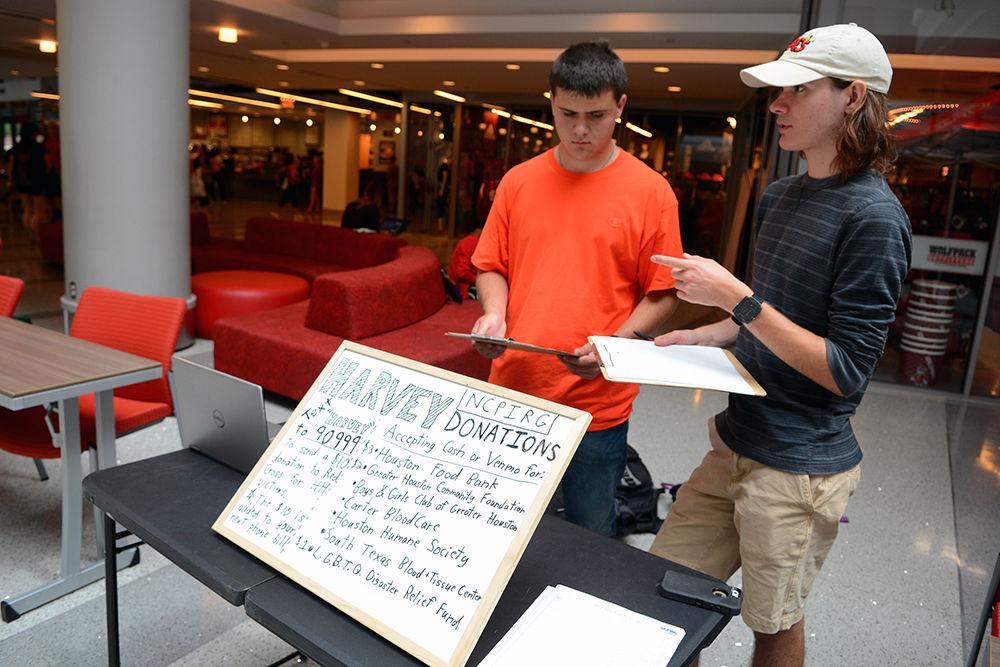NC State students over the past week have taken part in relief efforts to help those affected by Hurricane Harvey. Harvey, which made landfall on Aug. 25, caused large-scale flooding in southern Texas and Louisiana.
Brendan Vasarhelyi, a second-year studying environmental engineering and the off-campus coordinator intern for NCPIRG, a nonpartisan, nonprofit group that works to promote different campaigns on campus, spoke about the Hurricane Harvey fundraiser held by the organization Wednesday.
“This is part of our Hunger and Homelessness [project] cause,” Vasarhelyi said. “There’s a lot of people who got displaced in Hurricane Harvey and need new homes and food and stuff. We’re just giving donations to organizations like Red Cross that can go out there and help them. It’s easier than, say, cans that you’ve got to ship there. Nobody walks around with cans.”
Brian Eder, a meteorology professor at NC State, said most of the damage was caused by the unusually heavy rainfall, which occurred over a short period of time.
“While wind and storm surge, due to saltwater, flooding was extreme, it was limited to the coastline,” Eder said. “The dollar estimates are yet to be determined, but many experts expect it to fall between Superstorm Sandy and Hurricane Katrina.”
Eder believes that flooding like that seen in Texas could be disastrous for North Carolina.
“You can just look to Matthew from last year and get an estimate of what damage might occur,” Eder said. “Matthew dumped about half of the rain compared to Harvey. Also keep in mind that NC doesn’t have a city nearly as large as Houston, so the dollar amounts would be less.”
Emily Breines, a second-year studying political science, is also helping with the relief efforts. She started a relief drive for the residents of Wolf Village.
“I researched a lot about different organizations taking in things, like all the products that were on the list and monetary donations,” Breines said. “I saw the [Carolina] Hurricanes were doing something and that was definitely the best way to have to avoid shipping everything too. They’re driving, I think, a big truck down there full of whatever people bring, and all those products there just going to go and distribute it in the community to whoever needs it.”
The relief drive started Tuesday, and Breines believes that the response was so far positive.
“We put out all the bins and everything, but a lot of the people I’ve talked to seem really excited about it,” Breines said. “It’s kind of hard to like find a way to get involved up here. I feel like there hasn’t been a lot of options, so even if it doesn’t get a big response, any response, it’s good just to be able to help in any way.”
Breines feels that being involved in community service and helping people affected by disaster is an important cause, and one she has been dedicated to since high school.
“I feel like we grew up with Hurricane Katrina at a young age, kind of seeing how hard that was for their community to come back, and we’ve had to see the past however many years of them rebuilding,” Breines said. “At this point they’re still not completely back to where they were before the hurricane, so kind of being able to a part of being able to get people back on their feet I think is something I’m really interested in.”
With the approach of Hurricane Irma, Eder is concerned that North Carolina may be in need of relief soon as well. Gov. Roy Cooper declared a state of emergency in preparation for Irma Wednesday evening.
“I think it will first strike eastern Florida then move north into South Carolina and North Carolina,” Eder said. “If it makes landfall in South Carolina, most damage in North Carolina will be due to flooding rains. If it were to make landfall in North Carolina, then Fran-like damage would occur.”
Hurricane Fran caused 24 deaths and $7.2 billion in damage in North Carolina in 1996.








